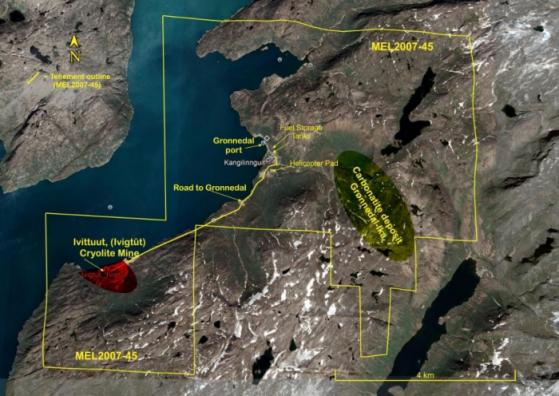Eclipse Metals Ltd (ASX:EPM) has its sights set on securing a mining licence for its Ivittuut Project in Greenland in 2021, which has near-term cryolite, fluorite and rare earth production potential from processing tailings and low-grade stockpiles.
The company is confident the project has the potential for a large, highly profitable industrial mineral/REE operation in the mining-friendly jurisdiction.
In the next 6-12 months Eclipse is targeting a resource upgrade, the mining licence application, environmental assessment, pit water testing and dewatering design – and a pre-feasibility study in 2021/2022.
Ivittuut development opportunities
The mine process tailings and remnant stockpiles highlight the short-term cashflow potential of the existing Ivittuut pit – which was once the world’s largest and only cryolite mine, producing 3.8 million tonnes of cryolite during a 120-year mining history, ceasing in 1987.
Industrial minerals include:
- Cryolite: Eclipse has identified high-grade cryolite-fluorite zones within and beneath Ivittuut pit using 3D modelling;
- Fluorite: the fluorite zone at Ivittuut is known to contain rare earth element (REE) mineralisation;
- High silica grade quartz; and
- Zinc and iron.
In addition, REE mineralisation, which is increasing in demand due to new technology uses including electric vehicles, has been identified in and surrounding the Ivittuut pit and at the nearby Grønnedal-Ika prospect.
Quartz opportunity for PV products
Eclipse has also demonstrated high silica grade quartz mineralisation at Ivittuut below the historic open pit.
High silica grade quartz and high-grade quartz sand is essential for production of photovoltaic (PV) products, in high-end electronics and semiconductors, with end uses including silicon, quartz glass, optical fibre, solar cells and integrated circuit boards.
Notably, the high purity quartz (HPQ) market is expected to grow at a CAGR of 6.9% from $671.62 million in 2019 to $1.23 billion by 2027.
High-grade quartz is characterised by high grades of silica (SiO2 ) and low metal contaminants and the company is confident Ivittuut is suitable for the production of HPQ.
The company's Greenland assets.
Grønnedal-Ika exploration
There is also a carbonatite deposit (associated with REE) at Grønnedal-Ika, which is just 10 kilometres from Ivittuut.
It contains a source of carbonate rock, which is used to neutralise acid mine and process water produced by miners, and is much needed for Greenland’s mining industry.
This presents an opportunity to the company, with Eclipse easily able to ship carbonate rock from the existing Grønnedal port.
The company is confident that the Grønnedal-lka carbonatite complex has potential for at least two types of deposits:
- REE mineralisation occurs throughout the complex, especially in the late-stage veins where it occurs in various strontium enriched, REE-bearing mineralisation; and
- Carbonatite body is 2 kilometres by 1 kilometre and can offer potentially large tonnages of carbonate rock.
The company’s Australian assets are also on the radar, with exploration potential across base metals, manganese, uranium and vanadium.
At the Liverpool Uranium Project in the Northern Territory, ground geophysical surveys are planned, with 17 drill target zones identified.
The company is focused on the Devil's Elbow, Terrace and Ferricrete uranium prospects.
There is also potential to grow the project area with additional EL applications and negotiations underway with Traditional Owners for an exploration agreement.
HPQ forecast demand.
Ngalia Basin uranium assets
At the Ngalia Basin in the Northern Territory, which is prospective for sandstone paleochannel-style uranium and vanadium mineralisation, Eclipse is negotiating with Traditional Owners for access to land for further exploration.
The Ngalia Basin hosts uranium/vanadium deposits including:
- Bigrlyi Deposit (7.5 million tonnes at 0.13% uranium and 0.12% vanadium);
- Capper Deposit (22 million tonnes at 0.015% uranium); and
- Napperby Project (9.54 million tonnes at 0.038% uranium).
Rock Hill and Mary Valley
At the Rock Hill Copper Prospect, the company is planning an airborne EM survey and RC drilling program over strongly mineralised zones, with infill diamond drilling to follow dependent on results.
The company also holds 35 square kilometres with high-grade manganese with bulk mining potential in the Mary Valley region of Queensland.
Manganese is in demand for the lithium-ion battery market and the company plans to undertake bulk sampling in the near term – targeting a bulk mining permit in 2021.
Read more on Proactive Investors AU
